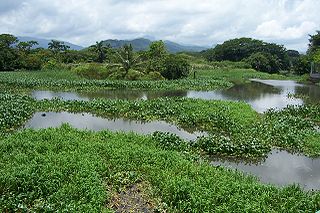
Ceiba is a genus of trees in the family Malvaceae, native to tropical and subtropical areas of the Americas and tropical West Africa. Some species can grow to 70 m (230 ft) tall or more, with a straight, largely branchless trunk that culminates in a huge, spreading canopy, and buttress roots that can be taller than a grown person. The best-known, and most widely cultivated, species is Kapok, Ceiba pentandra, one of several trees known as kapok. Ceiba is a word from the Taíno language meaning "boat" because Taínos use the wood to build their dugout canoes.

Atlántida is a department located on the north Caribbean shore of Honduras, Central America. The capital is the port city of La Ceiba.

La Ceiba is a municipality, the capital of the Honduran department of Atlántida and a port city on the northern coast of Honduras in Central America. It is located on the southern edge of the Caribbean, forming part of the south eastern boundary of the Gulf of Honduras. With an estimated population of 209,000 living in approximately 170 residential areas, it is the fourth most populous and third most important city in the country.
Isleña de Inversiones S.A. de C.V. branded Avianca Honduras was an regional airline based in San Pedro Sula, Honduras. It offered mostly scheduled and chartered passenger flights out of its hub at Ramón Villeda Morales International Airport. It was one of the most successful airlines in the country and in the Central American region, as it was part of Grupo TACA. It was one of the seven nationally branded airlines in the Avianca Group of Latin American airlines.

Siguatepeque is a city and municipality in the Honduran department of Comayagua. The city has a population of 79,520.

Golosón International Airport is an airport located on the western side of the city of La Ceiba, in the Atlántida Department on the north coast of Honduras. It is also known as La Ceiba Airport and Hector C. Moncada Air Base.

Club Deportivo y Social Vida, or simply Vida, is a Honduran football club based in La Ceiba, Atlántida.

Club Deportivo Victoria is a Honduran football club based in La Ceiba, Atlántida. They have enjoyed success in the past having won the Honduran first division once. They currently play in the Honduran first division.
Mazapan School is a N-12 co-educational bilingual school offering a US-style college preparatory instruction program. Owned and operated by Standard Fruit de Honduras (Dole), Mazapan School is located in La Ceiba, Honduras. Founded in 1928, the landscaped campus is located on 5 acres (20,000 m2). The 300+ students attending Mazapan School are taught in English and Spanish, and receive a U.S. High School diploma and a Honduran Baccalaureate degree.
The American School of Tegucigalpa is a private, coeducational international school located in the neighbourhood of Lomas del Guijarro, in Tegucigalpa, Honduras.
The 1976–77 Honduran Liga Nacional season was the 11th edition of the Honduran Liga Nacional. The format of the tournament remained the same as the previous season. C.D. España won the title after defeating C.D. Motagua in the finals. Both teams qualified to the 1977 CONCACAF Champions' Cup.
The 1986–87 Honduran Liga Nacional season was the 21st edition of the Honduran Liga Nacional. The format of the tournament remained the same as the previous season. Club Deportivo Olimpia won the title after winning the final round and qualified to the 1987 CONCACAF Champions' Cup along with runners-up Real C.D. España.
The 1987–88 Honduran Liga Nacional season was the 22nd edition of the Honduran Liga Nacional. The format of the tournament consisted of two groups of five followed by a 5-team playoff round. Club Deportivo Olimpia won the title after defeating C.D. Marathón in the finals. Both teams qualified to the 1988 CONCACAF Champions' Cup.
The 1969–70 Honduran Liga Nacional season was the 5th edition of the Honduran Liga Nacional. The format of the tournament remained the same as the previous season. Club Deportivo Olimpia won the title and qualified to the 1970 CONCACAF Champions' Cup.
The 1983–84 Honduran Liga Nacional season was the 18th edition of the Honduran Liga Nacional. The format of the tournament consisted of a four round-robin schedule. C.D.S. Vida won the title and qualified to the 1984 CONCACAF Champions' Cup along with runners-up Universidad.
The 1968–69 Honduran Liga Nacional season was the 4th edition of the Honduran Liga Nacional. The format of the tournament consisted of a three round-robin schedule. C.D. Motagua won the title and qualified to the 1969 CONCACAF Champions' Cup.
The 1984–85 Honduran Liga Nacional season was the 19th edition of the Honduran Liga Nacional. The format of the tournament consisted of a four round-robin schedule followed by a 4-team playoff round. Club Deportivo Olimpia won the title after winning both rounds and qualified to the 1985 CONCACAF Champions' Cup along with runners-up C.D.S. Vida.

Guillermo Anderson was one of the best known Honduran musicians. A singer-songwriter, his lyrics often touch upon themes of ecology and social problems.
This page is based on this
Wikipedia article Text is available under the
CC BY-SA 4.0 license; additional terms may apply.
Images, videos and audio are available under their respective licenses.








